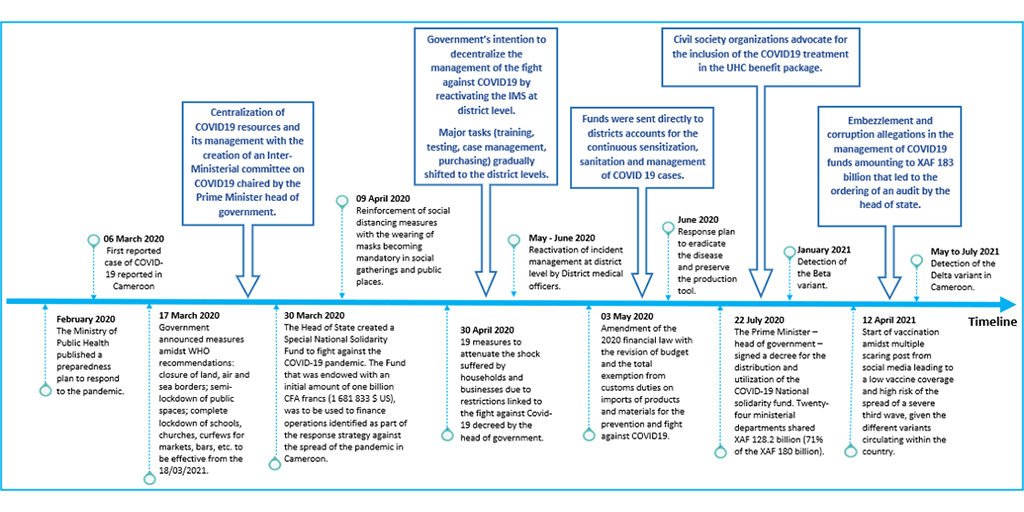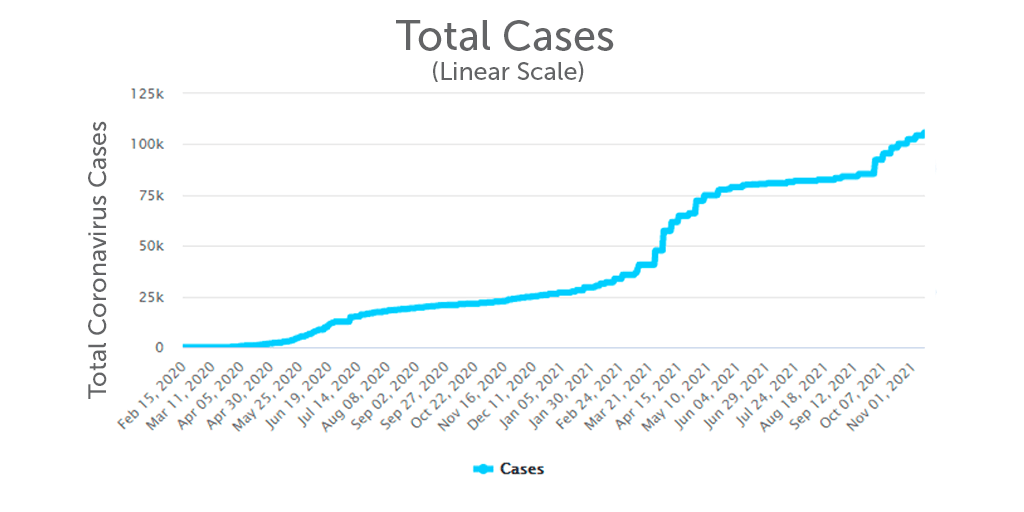COVID-19’s Impact on Strategic Health Purchasing: Lessons from Cameroon
Collectivity Series: 3 of 5
[Editor’s Note: This is the third post in a blog series by a group focused on strategic purchasing, working through Collectivity — a collaborative learning platform for global, regional and country experts. This series features insights from six country teams that explored how governments have adjusted their health purchasing arrangements to support the COVID-19 health response, as part of a project co-facilitated by R4D, the Strategic Purchasing Africa Resource Center and the World Health Organization. Jointly, these country teams are seeking to draw lessons for the future, and share reflections on whether these adjustments contribute to making purchasing more strategic. In this post, the Collectivity’s Cameroon team shares takeaways from the government’s decentralized management of its COVID-19 response.]
When COVID-19 first arrived in Cameroon, the country was already facing several ongoing crises, including the political crisis in the northwest and southwest regions, the Boko Haram insecurities in the northern region, and the refugee crisis in the East regions (due to the political instability in the neighboring Central Africa Republic). These situations, compounded with COVID-19 pandemic, put a strain on the already insufficient financial resources and underlined the imperative necessity to manage them efficiently.
The first case of COVID was detected in Cameroon in early March 2019. Since then, the number of cases has risen — placing the country at the third position of sub–Saharan African most infected countries with 104,348 confirmed cases and 1,731 deaths.
In this post, we unpack the decentralization process of the management of the COVID-19 in Cameroon and its impact on strategic purchasing arrangements.
Figure 1: Evolution of the number of COVID-19 cases in Cameroon
Source: Worldometer
To mitigate the negative effects of the pandemic on the population, the Cameroonian authorities opted for a response plan that would lead to both the eradication of the disease and the preservation of the production tool. The said strategy that was unveiled on June 17, 2020 is based on five major pillars, namely the health response, economic and financial resilience, strategic purchasing, strengthening of research and innovation, as well as social resilience. The implementation of the response strategy was hampered by the highly centralized and heavily bureaucratic nature of the governance system of the country, especially at the level of purchasing arrangement where all decisions were taken from the central level and funds managed in total secrecy.
A timeline of the response to COVID-19 across the national, regional and district levels
Faced with the rapid increase in the number of cases across the country, the government had to decentralize the management of the crisis. This was done by reactivating the already existing, Incident Management System (IMS) at the regional headquarters. The IMS is a multi-sectorial working group coordinated by the Prime Minister, head of government, created in 2015 to manage major public health crisis in Cameroon. It was first experimented on a smaller scale during a cholera outbreak that hit the country in 2018.
In April 2020, most districts had not yet received rapid diagnostic tests kits; management of COVID-19 cases was still centered at regional hospitals.
By June 2020, the tasks were gradually shifting to the district hospitals. They began training of health care providers on management of COVID cases. Many district hospitals could carry out testing and even management of COVID patients. There were massive sensitizations and screenings at all entry point.
In August 2020, the minister of public health directly supported all districts in Cameroon financially — with commendable speed. Funds were sent directly to the accounts of the District Medical Office (Incident managers at district level) for the continuous sensitization, sanitation and management of COVID-19 cases.
Today, there are enough testing kits in most public health facilities in the country. Currently, all districts have been empowered with purchasing arrangements in particular for the acquisition of COVID diagnostic test kits, the management of treatment and prevention services etc.; working hand in gloves with the councils.
Figure 2: Decentralization process of the management of the COVID-19 response plan in Cameroon.
4 specific purchasing elements were adjusted
For the decentralization process to be successful, four important adjustments were made to some key functions of strategic purchasing.
- Governance: An Inter-Ministerial committee on COVID-19, chaired by the Prime minister, head of government was established to coordinate a multi-sector response to COVID-19 in Cameroon, including resource mobilization and prioritization of needs. As the number of cases kept growing at an alarming rate, the purchasing decisions were gradually shifted to the district level with the reactivation of the incident management system (IMS) that existed but was dormant. Greater autonomy given to the peripheral on the management of funds and purchasing decisions. Mayors have been empowered by the government through allocation of funds to local councils for the purchase of COVID-19 commodities.
- Resource Mobilization and Allocation: In order to cope with the increase in resource needs to contain the COVID-19 pandemic, the Head of State created a Special National Solidarity Fund on the March 30, 2020 with an initial endowment of XAF 1 billion ($1 681 833). Existing funds were reallocated through a modification of the financial law on May 3, 2020, to create more flexibility in the use of funds and encouraging greater involvement of the formal private sector. On July 22, 2020, the Prime Minister signed a decree bearing on the distribution and utilization of the COVID-19 National Solidarity Fund. Twenty-four ministerial departments shared XAF 128.2 billion (71% of the XAF 180 billion). Transparency in the allocation and use of these resources was to be ensured through termly reporting by the vote holders concerned and an independent audit by the audit bench of the supreme court.
- Payment Mechanism: Adjustments were made to allow flexible and rapid use of funds by providers. Incentives such as the extension of the retirement age of public health personnel was introduced to motivate health workers. Testing and treatment services for COVID-19 were to be provided free of charge to patients in health facilities.
- Service Provision: New accreditation and expansion of public treatment centres and health benefit packages including testing, hospitalization, medication, were instituted. Isolation and treatment centres were created in the 10 regions of the country to cater to COVID-19 patients. Putting in place of a complaint mechanism with the provision of a hotline (1510) to the public.
There is unanimity on the fact that the adjustments on purchasing arrangements that were made during the decentralization and implementation of the response strategy by the government had a positive impact on the health system as a whole.
For example, the decentralization of services to district level led to clear lines of responsibility and accountability. As a results, districts purchasers now have more autonomy to take strategic decisions on what to buy, where to buy and how to buy materials like hand sanitizers, ventilators, gloves, mask, gowns, soap, boots and other preventive protective equipment.
This decentralized approach has also led to more streamlined processed, including the smooth and fast mobilization of resources and commodities to communities in need — as well as improved quality of service and transparency at district level with the effectiveness of the complaint mechanism.
Lessons learned from the COVID-19 pandemic experience
Here are few lessons we learned as a results of Cameroon’s decentralized management of the COVID process — and the adjustments to purchasing policies (for health services) the government had to make as a result:
- There is a great need for the development of a more intensive, broad-based, integrative, people-centered, bottom-up and multi-stakeholder process of purchase management in Cameroon.
- The technological improvements achieved in dealing with the COVID-19 pandemic can be used to establish a robust information management system and early warning system with an effective communication and feedback mechanism where government, leaders, and their constituents can directly contribute in preparing to prevent and respond to emerging challenges whether they are health-related or war-related crisis.
- Emphasis should be placed on a multi-sectorial approach for the preparedness against any pandemic in the future. Involvement of government officials, personnel with various specialties including policy development, legislative review and drafting, animal health, public health, patient care, laboratory diagnosis, laboratory test development, communication expertise and disaster management, just to name a few, is central to an effective emergency response program.
In the case COVID-19, Cameroon has learned a lot from the purchasing activities. For example, it is now clear that resources are efficiently managed when purchasers (Managers of IMS at district level) are given more autonomy in purchasing decisions. These decisions have to be taken in total transparency and linked to providers performances as much as possible.
The insights provided in this series are part of a larger research effort — led by Collectivity country teams — on the strategic purchasing reforms countries developed during the COVID-19 pandemic. Their collective research will culminate in a series of published journal articles. In upcoming posts, we’ll hear from Collectivity teams in Ghana and Ukraine. Click here to learn more on the Collectivity Group on Strategic Purchasing, which aims to contribute to the global knowledge base on strategic purchasing and strengthen the ecosystems that support countries to advance health financing and health system reforms.
Photo © Erick Kaglan/World Bank
Catch up on the Collectivity Blog Series
- Lessons from the Philippines
- Lessons from Armenia and Romania
- Lessons from Cameroon
- Lessons from Ghana
- Lessons from Ukraine














